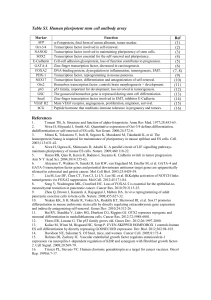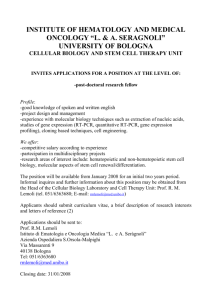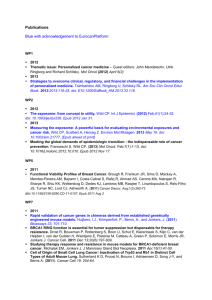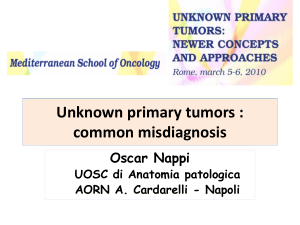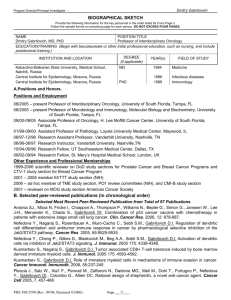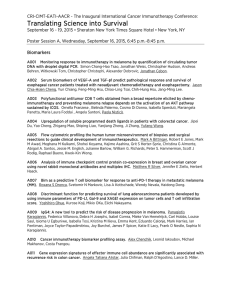Supplementary Table 6 (doc 248K)
advertisement
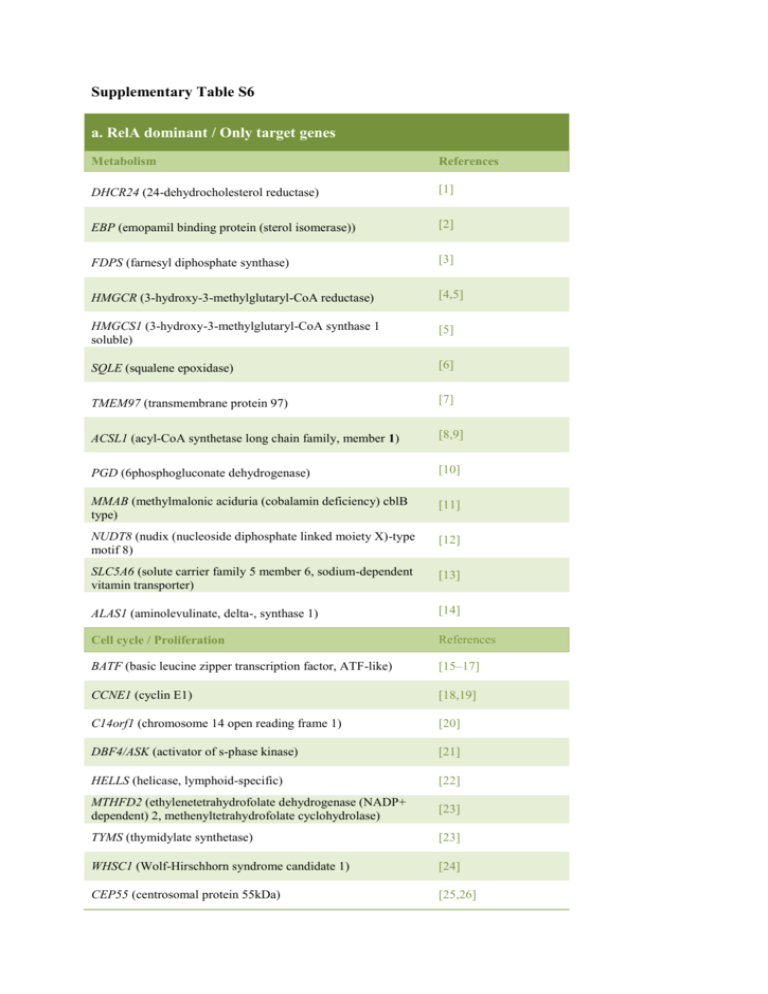
Supplementary Table S6 a. RelA dominant / Only target genes Metabolism References DHCR24 (24-dehydrocholesterol reductase) [1] EBP (emopamil binding protein (sterol isomerase)) [2] FDPS (farnesyl diphosphate synthase) [3] HMGCR (3-hydroxy-3-methylglutaryl-CoA reductase) [4,5] HMGCS1 (3-hydroxy-3-methylglutaryl-CoA synthase 1 soluble) [5] SQLE (squalene epoxidase) [6] TMEM97 (transmembrane protein 97) [7] ACSL1 (acyl-CoA synthetase long chain family, member 1) [8,9] PGD (6phosphogluconate dehydrogenase) [10] MMAB (methylmalonic aciduria (cobalamin deficiency) cblB type) [11] NUDT8 (nudix (nucleoside diphosphate linked moiety X)-type motif 8) [12] SLC5A6 (solute carrier family 5 member 6, sodium-dependent vitamin transporter) [13] ALAS1 (aminolevulinate, delta-, synthase 1) [14] Cell cycle / Proliferation References BATF (basic leucine zipper transcription factor, ATF-like) [15–17] CCNE1 (cyclin E1) [18,19] C14orf1 (chromosome 14 open reading frame 1) [20] DBF4/ASK (activator of s-phase kinase) [21] HELLS (helicase, lymphoid-specific) [22] MTHFD2 (ethylenetetrahydrofolate dehydrogenase (NADP+ dependent) 2, methenyltetrahydrofolate cyclohydrolase) [23] TYMS (thymidylate synthetase) [23] WHSC1 (Wolf-Hirschhorn syndrome candidate 1) [24] CEP55 (centrosomal protein 55kDa) [25,26] TCF19/SC1 (transcription factor 19) [27] Genetic instability References APOBECB3 (apolipoprotein B mRNA editing enzyme, catalytic polypeptide-like 3B) [28] Anti-apoptotic factors References E2F7 (E2F transcription factor 7) [29,30] NAB1 (NGFI-A binding protein 1) [31,32] SRI (sorcin) [33,34] TRAF4 (TNF receptor-associated factor 4) [35] Immune response References CD58/LFA3 (lymphocyte function-associated antigen, type 3) [36] CD80/B7.1 (CD80 molecule) [37] IL1R2 (interleukin 1 receptor, type II) [38] IL4I1 (interleukin 4 induced 1) [39] EBI3 (Epstein-Barr virus induced 3, IL27 subunit, IL35 subunit) [40] SRGN (serglycin) [41] b. RelA and RelB co-dominant target genes Metabolism References ACAT2 (acetyl-CoA acetyltransferase 2) [5] LACTB/MRPL56 (lactamase, beta) [42] SORD (sorbitol dehydrogenase) [43] STX11 (syntaxin 11) [44] Autophagy regulator References DRAM1 (DNA-damage regulated autophagy modulator 1) [45,46] Transcriptional factors and regulators References NFKBIA/IKBA (nuclear factor of kappa light polypeptide gene enhancer in B-cells inhibitor, alpha) [47] TNFRSF8/CD30 (tumor necrosis factor receptor superfamily, member 8) [48,49] TRAF1 (TNF receptor-associated factor 1) [50] TTF2 (transcription termination factor, RNA polymerase II) [51] ZBTB32 (zinc finger and BTB domain containing 32) [15,52] Immune response References ICAM1 (intercellular adhesion molecule 1) [53] c. RelB only target genes Circadian rhythm and hypoxia protection References ARNTL2/MOP9/CLIF (aryl hydrocarbon receptor nuclear translocator-like 2) [54–56] References 1 Di Stasi D, Vallacchi V, Campi V, Ranzani T, Daniotti M, Chiodini E, et al. DHCR24 gene expression is upregulated in melanoma metastases and associated to resistance to oxidative stress-induced apoptosis. Int J Cancer J Int Cancer 2005; 115:224–230. 2 Acimovic J, Korosec T, Seliskar M, Bjorkhem I, Monostory K, Szabo P, et al. Inhibition of human sterol Δ7-reductase and other postlanosterol enzymes by LK-980, a novel inhibitor of cholesterol synthesis. Drug Metab Dispos Biol Fate Chem 2011; 39:39–46. 3 Zhang F, Dai X, Wang Y. 5-Aza-2’-deoxycytidine induced growth inhibition of leukemia cells through modulating endogenous cholesterol biosynthesis. Mol Cell Proteomics MCP 2012; 11:M111.016915. 4 Newman A, Clutterbuck RD, Powles RL, Catovsky D, Millar JL. A comparison of the effect of the 3-hydroxy-3-methylglutaryl coenzyme A (HMG-CoA) reductase inhibitors simvastatin, lovastatin and pravastatin on leukaemic and normal bone marrow progenitors. Leuk Lymphoma 1997; 24:533–537. 5 Santos CR, Schulze A. Lipid metabolism in cancer. FEBS J 2012; 279:2610–2623. 6 Helms MW, Kemming D, Pospisil H, Vogt U, Buerger H, Korsching E, et al. Squalene epoxidase, located on chromosome 8q24.1, is upregulated in 8q+ breast cancer and indicates poor clinical outcome in stage I and II disease. Br J Cancer 2008; 99:774–780. 7 Wilcox CB, Feddes GO, Willett-Brozick JE, Hsu L-C, DeLoia JA, Baysal BE. Coordinate up-regulation of TMEM97 and cholesterol biosynthesis genes in normal ovarian surface epithelial cells treated with progesterone: implications for pathogenesis of ovarian cancer. BMC Cancer 2007; 7:223. 8 Samudio I, Harmancey R, Fiegl M, Kantarjian H, Konopleva M, Korchin B, et al. Pharmacologic inhibition of fatty acid oxidation sensitizes human leukemia cells to apoptosis induction. J Clin Invest 2010; 120:142–156. 9 Pike LS, Smift AL, Croteau NJ, Ferrick DA, Wu M. Inhibition of fatty acid oxidation by etomoxir impairs NADPH production and increases reactive oxygen species resulting in ATP depletion and cell death in human glioblastoma cells. Biochim Biophys Acta 2011; 1807:726–734. 10 Rysman E, Brusselmans K, Scheys K, Timmermans L, Derua R, Munck S, et al. De novo lipogenesis protects cancer cells from free radicals and chemotherapeutics by promoting membrane lipid saturation. Cancer Res 2010; 70:8117–8126. 11 Saridakis V, Yakunin A, Xu X, Anandakumar P, Pennycooke M, Gu J, et al. The structural basis for methylmalonic aciduria. The crystal structure of archaeal ATP:cobalamin adenosyltransferase. J Biol Chem 2004; 279:23646–23653. 12 McLennan AG. The Nudix hydrolase superfamily. Cell Mol Life Sci CMLS 2006; 63:123–143. 13 Prasad PD, Wang H, Kekuda R, Fujita T, Fei YJ, Devoe LD, et al. Cloning and functional expression of a cDNA encoding a mammalian sodium-dependent vitamin transporter mediating the uptake of pantothenate, biotin, and lipoate. J Biol Chem 1998; 273:7501–7506. 14 Puy H, Gouya L, Deybach J-C. Porphyrias. Lancet 2010; 375:924–937. 15 Care MA, Barrans S, Worrillow L, Jack A, Westhead DR, Tooze RM. A microarray platform-independent classification tool for cell of origin class allows comparative analysis of gene expression in diffuse large Bcell lymphoma. PloS One 2013; 8:e55895. 16 Farrell CJ, Lee JM, Shin E-C, Cebrat M, Cole PA, Hayward SD. Inhibition of Epstein-Barr virus-induced growth proliferation by a nuclear antigen EBNA2-TAT peptide. Proc Natl Acad Sci U S A 2004; 101:4625–4630. 17 Johansen LM, Deppmann CD, Erickson KD, Coffin WF 3rd, Thornton TM, Humphrey SE, et al. EBNA2 and activated Notch induce expression of BATF. J Virol 2003; 77:6029–6040. 18 Hwang HC, Clurman BE. Cyclin E in normal and neoplastic cell cycles. Oncogene 2005; 24:2776–2786. 19 Tzankov A, Gschwendtner A, Augustin F, Fiegl M, Obermann EC, Dirnhofer S, et al. Diffuse large B-cell lymphoma with overexpression of cyclin e substantiates poor standard treatment response and inferior outcome. Clin Cancer Res Off J Am Assoc Cancer Res 2006; 12:2125– 2132. 20 Lee CN, Heidbrink JL, McKinnon K, Bushman V, Olsen H, FitzHugh W, et al. RNA Interference Characterization of Proteins Discovered by Proteomic Analysis of Pancreatic Cancer Reveals Function in Cell Growth and Survival. Pancreas 2012; 41:84–94. 21 Kumagai H, Sato N, Yamada M, Mahony D, Seghezzi W, Lees E, et al. A novel growth- and cell cycle-regulated protein, ASK, activates human Cdc7-related kinase and is essential for G1/S transition in mammalian cells. Mol Cell Biol 1999; 19:5083–5095. 22 Geiman TM, Muegge K. Lsh, an SNF2/helicase family member, is required for proliferation of mature T lymphocytes. Proc Natl Acad Sci U S A 2000; 97:4772–4777. 23 Lim U, Wang SS, Hartge P, Cozen W, Kelemen LE, Chanock S, et al. Gene-nutrient interactions among determinants of folate and one-carbon metabolism on the risk of non-Hodgkin lymphoma: NCI-SEER CaseControl Study. Blood 2007; 109:3050–3059. 24 Min D-J, Ezponda T, Kim MK, Will CM, Martinez-Garcia E, Popovic R, et al. MMSET stimulates myeloma cell growth through microRNAmediated modulation of c-MYC. Leukemia Published Online First: 13 September 2012. doi:10.1038/leu.2012.269 25 Martinez-Garay I, Rustom A, Gerdes H-H, Kutsche K. The novel centrosomal associated protein CEP55 is present in the spindle midzone and the midbody. Genomics 2006; 87:243–253. 26 Waseem A, Ali M, Odell EW, Fortune F, Teh M-T. Downstream targets of FOXM1: CEP55 and HELLS are cancer progression markers of head and neck squamous cell carcinoma. Oral Oncol 2010; 46:536–542. 27 Krishnan BR, Jamry I, Chaplin DD. Feature mapping of the HLA class I region: localization of the POU5F1 and TCF19 genes. Genomics 1995; 30:53–58. 28 Shinohara M, Io K, Shindo K, Matsui M, Sakamoto T, Tada K, et al. APOBEC3B can impair genomic stability by inducing base substitutions in genomic DNA in human cells. Sci Reports 2012; 2:806. 29 Li J, Ran C, Li E, Gordon F, Comstock G, Siddiqui H, et al. Synergistic function of E2F7 and E2F8 is essential for cell survival and embryonic development. Dev Cell 2008; 14:62–75. 30 Moon N-S, Dyson N. E2F7 and E2F8 keep the E2F family in balance. Dev Cell 2008; 14:1–3. 31 Das A, Chendil D, Dey S, Mohiuddin M, Mohiuddin M, Milbrandt J, et al. Ionizing radiation down-regulates p53 protein in primary Egr-1-/mouse embryonic fibroblast cells causing enhanced resistance to apoptosis. J Biol Chem 2001; 276:3279–3286. 32 Thiel G, Kaufmann K, Magin A, Lietz M, Bach K, Cramer M. The human transcriptional repressor protein NAB1: expression and biological activity. Biochim Biophys Acta 2000; 1493:289–301. 33 Maxwell SA, Cherry EM, Bayless KJ. Akt, 14-3-3ζ, and vimentin mediate a drug-resistant invasive phenotype in diffuse large B-cell lymphoma. Leuk Lymphoma 2011; 52:849–864. 34 Qi J, Liu N, Zhou Y, Tan Y, Cheng Y, Yang C, et al. Overexpression of sorcin in multidrug resistant human leukemia cells and its role in regulating cell apoptosis. Biochem Biophys Res Commun 2006; 349:303–309. 35 Fleckenstein DS, Dirks WG, Drexler HG, Quentmeier H. Tumor necrosis factor receptor-associated factor (TRAF) 4 is a new binding partner for the p70S6 serine/threonine kinase. Leuk Res 2003; 27:687– 694. 36 Challa-Malladi M, Lieu YK, Califano O, Holmes AB, Bhagat G, Murty VV, et al. Combined genetic inactivation of β2-Microglobulin and CD58 reveals frequent escape from immune recognition in diffuse large B cell lymphoma. Cancer Cell 2011; 20:728–740. 37 Vinjamaram S, Czuczman MS, Hernandez-Ilizaliturri FJ. The use of galiximab in non-Hodgkin lymphoma. Clin Lymphoma Myeloma 2008; 8:277–282. 38 Ma Y, Visser L, Roelofsen H, de Vries M, Diepstra A, van Imhoff G, et al. Proteomics analysis of Hodgkin lymphoma: identification of new players involved in the cross-talk between HRS cells and infiltrating lymphocytes. Blood 2008; 111:2339–2346. 39 Carbonnelle-Puscian A, Copie-Bergman C, Baia M, Martin-Garcia N, Allory Y, Haioun C, et al. The novel immunosuppressive enzyme IL4I1 is expressed by neoplastic cells of several B-cell lymphomas and by tumor-associated macrophages. Leukemia 2009; 23:952–960. 40 Gonin J, Larousserie F, Bastard C, Picquenot J-M, Couturier J, RadfordWeiss I, et al. Epstein-Barr virus-induced gene 3 (EBI3): a novel diagnosis marker in Burkitt lymphoma and diffuse large B-cell lymphoma. PloS One 2011; 6:e24617. 41 Kolset SO, Pejler G. Serglycin: a structural and functional chameleon with wide impact on immune cells. J Immunol Baltim Md 1950 2011; 187:4927–4933. 42 Koc EC, Burkhart W, Blackburn K, Moyer MB, Schlatzer DM, Moseley A, et al. The Large Subunit of the Mammalian Mitochondrial Ribosome ANALYSIS OF THE COMPLEMENT OF RIBOSOMAL PROTEINS PRESENT. J Biol Chem 2001; 276:43958–43969. 43 Sato S, Secchi EF, Sakurai S, Ohta N, Fukase S, Lizak MJ. NADPHdependent reductases and polyol formation in human leukemia cell lines. Chem Biol Interact 2003; 143-144:363–371. 44 Valdez AC, Cabaniols JP, Brown MJ, Roche PA. Syntaxin 11 is associated with SNAP-23 on late endosomes and the trans-Golgi network. J Cell Sci 1999; 112 ( Pt 6):845–854. 45 Crighton D, Wilkinson S, O’Prey J, Syed N, Smith P, Harrison PR, et al. DRAM, a p53-induced modulator of autophagy, is critical for apoptosis. Cell 2006; 126:121–134. 46 Mathew R, Karantza-Wadsworth V, White E. Role of autophagy in cancer. Nat Rev Cancer 2007; 7:961–967. 47 Hoffmann A, Levchenko A, Scott ML, Baltimore D. The IkappaB-NFkappaB signaling module: temporal control and selective gene activation. Science 2002; 298:1241–1245. 48 Chao C, Silverberg MJ, Martínez-Maza O, Chi M, Abrams DI, Haque R, et al. Epstein-Barr virus infection and expression of B-cell oncogenic markers in HIV-related diffuse large B-cell Lymphoma. Clin Cancer Res Off J Am Assoc Cancer Res 2012; 18:4702–4712. 49 Al-Shamkhani A. The role of CD30 in the pathogenesis of haematopoietic malignancies. Curr Opin Pharmacol 2004; 4:355–359. 50 Ramalingam P, Chu W-S, Tubbs R, Rybicki L, Pettay J, Hsi ED. Latent membrane protein 1, tumor necrosis factor receptor-associated factor (TRAF) 1, TRAF-2, TRAF-3, and nuclear factor kappa B expression in posttransplantation lymphoproliferative disorders. Arch Pathol Lab Med 2003; 127:1335–1339. 51 Jiang Y, Liu M, Spencer CA, Price DH. Involvement of transcription termination factor 2 in mitotic repression of transcription elongation. Mol Cell 2004; 14:375–385. 52 Young LS, Rickinson AB. Epstein-Barr virus: 40 years on. Nat Rev Cancer 2004; 4:757–768. 53 Lalancette M, Aoudjit F, Potworowski EF, St-Pierre Y. Resistance of ICAM-1-deficient mice to metastasis overcome by increased aggressiveness of lymphoma cells. Blood 2000; 95:314–319. 54 Hogenesch JB, Gu YZ, Moran SM, Shimomura K, Radcliffe LA, Takahashi JS, et al. The basic helix-loop-helix-PAS protein MOP9 is a brain-specific heterodimeric partner of circadian and hypoxia factors. J Neurosci Off J Soc Neurosci 2000; 20:RC83. 55 Maemura K, de la Monte SM, Chin MT, Layne MD, Hsieh CM, Yet SF, et al. CLIF, a novel cycle-like factor, regulates the circadian oscillation of plasminogen activator inhibitor-1 gene expression. J Biol Chem 2000; 275:36847–36851. 56 Mazzoccoli G, Pazienza V, Panza A, Valvano MR, Benegiamo G, Vinciguerra M, et al. ARNTL2 and SERPINE1: potential biomarkers for tumor aggressiveness in colorectal cancer. J Cancer Res Clin Oncol 2012; 138:501–511.
